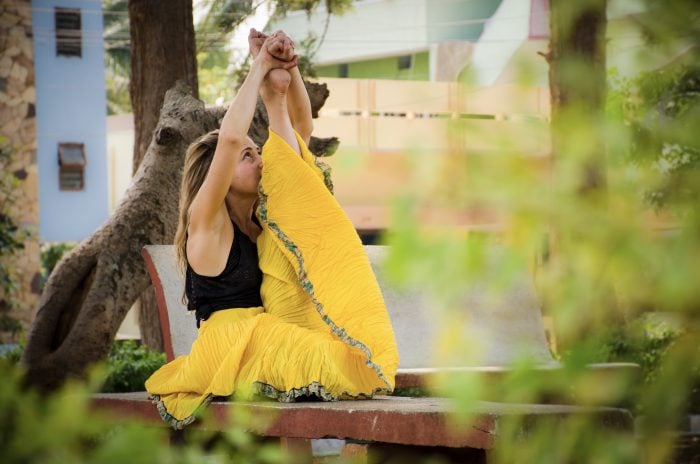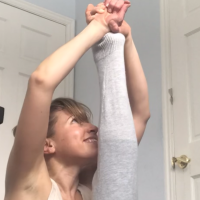I never thought when I took my Ashtanga practice home that I was becoming a yoga doomsday prepper, but hey, if the shoe fits…
I began a home practice of Ashtanga seven years ago when I moved away from the Ashtanga-haven of D.C. I had a choice— take my practice home, or give it up.
Funny thing is, so many people have joined me in this position in the last few months, but because of a pandemic. Many feel understandably lost with studios closed and a dizzying array of Zoom offerings. For me? My practice hasn’t really changed. I’ve had a home space in my bedroom set up for a while now, so I’ve had this practice to keep me sane.
In fact, there’s never been a better time to practice Ashtanga yoga.
Even as studios reopen, some of us may feel more comfortable keeping yoga at home—because it feels safer, or we’re squeezing it in alongside homeschooling kids and managing jobs, or perhaps we live with someone who is vulnerable.
There’s never been a better time to learn this practice, so you can have it for yourself—come COVID-19, lockdowns, or a new wave of pandemic.
This practice is yours. It’s mine. It’s inside of all of us. With Ashtanga, we can find a yoga practice inside—a freedom that cannot be taken away—lockdown, or not.
Here’s why the Ashtanga yoga practice is perfect for quarantine:
1. The choreography is pretty much set.
Many don’t know what to do when practicing alone, so home practice seems like a poor substitute for studio life. In Ashtanga, we’ve got choreography for that. Not that we have to do everything in any series or exactly as stated—five minutes is enough. But there’s a framework to keep us focused so we don’t step onto the mat and wonder, “Now what?”
It worked best for me to learn the postures directly from a teacher. This may prove challenging now, but there’s ample opportunity to reach out to great teachers online. Most days I practice alone, but I enjoy Zoom Mysore sessions with my home studio in SLC (which carves out a space for beginners during the session), as well as with The Ashtanga Yoga Center in Encinitas, which also has beginner classes online.
2. It’s designed for self-practice (even when in a studio).
Really. Pre-COVID, even in a packed Mysore room (where Ashtangis practice at their own pace) the teacher walks around and assists students as needed. At any given moment, students are all somewhere different in their practices, at different speeds and levels. We’re engaged in self-practice—together.
3. You can find Mysore magic home alone, even if you’re used to a packed room.
It may not be the same, but it doesn’t have to be that different. When I transitioned my Ashtanga practice from the D.C. Mysore room to my home, next to my toddler’s crib, I often wondered if it would ever feel “real.” Years later, I know: I make this practice real. My love for this practice makes it real. Sure, some days are easier than others. But no practice is ever wasted, and no practice is ever fake.
4. You don’t have to go it alone.
We can all get guidance from a teacher through online Mysore introductory and led classes. When I log into Zoom Mysore, I feel my heart lift because the practice, even over the web, is interactive and personal. I feel seen. And in taking up home practice years ago, I found a whole community of home practitioners on Instagram. I have friends all over the world who share this practice I love. In these scary times, it’s a lovely thing to still be in this together.
5. Ashtanga is flexible enough to work with whatever comes up.
Perhaps you’ve heard Ashtanga is rigid and dogmatic. In my experience, it’s anything but—instead, I can mold it to suit my needs when injured, after surgery, and throughout a pandemic. The important thing I’ve found is to have a habit. In tougher times, maintaining that habit can be as simple as five minutes. It may be as simple as sun salutations and the essential standing postures and a brief closing—a short practice that supports me like bedrock, and preserves the habit in my system for when, and if, I’m ready to do more.
No matter the conditions, this practice of Ashtanga is there. It’s yours. It doesn’t have to be 90 minutes. Get that out of your head. Your practice counts, as long as it is practice.
Ashtanga yoga, particularly practiced home alone, asks us to figure things out creatively—navigating the obstacles in the physical practice or in life, working around injuries and other limitations, making practice work around kids, jobs, losses, lockdowns, and it helps us in finding a way to breathe in cramped spaces (Marichyasana D, anyone?).
If I can learn how to use furniture to assist me in a posture, and if I can make my practice special home alone, I can surely make my kid’s birthday in quarantine special too. These skills I practice on my mat, these gymnastic moves and twists and jumps, they ripple out into my life in these crazy times.
Sharon Salzberg recently posed the question: “What’s still true? What hasn’t been broken?”
This practice. Yoga. The inhale in my lungs.
I hope we get to a place where we can gather together to practice again. In the meantime, we’ve got Ashtanga to build a practice of our own home alone, a practice inside of us. But don’t worry—so many of us are out there doing it:
We’ll be anything but isolated.
~
 Share on bsky
Share on bsky






Read 3 comments and reply